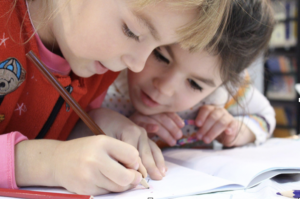
Your child is sitting in the exam room chair for their annual eye check-up, and they are asked the notorious question that you always seem to overthink: “Which is better… 1… or… 2…” Did you know that optometrists are testing for visual acuity when they ask that question? But did you also know there are many more aspects of vision than just visual acuity that could be influencing your child’s ability to learn and play? Read on to learn more about how to spot the difference between visual skills!
Who is at risk for visual issues?
The American Optometric Association identifies factors that increase your child’s risk for developing eye and vision problems, some of which include:
- Prematurity, low birth weight, and/or prolonged supplemental oxygen at birth
- Conditions such as myopia (nearsightedness), hyperopia (farsightedness), amblyopia (“lazy eye”), strabismus (misalignment of the eyes), congenital cataracts, or other genetic conditions
- Prenatal drug or alcohol exposure
- Injury to the areas of the brain that are responsible for vision (cortical visual impairment)
- Direct injury or trauma to the eye
It is recommended by the American Optometric Association that your child has a comprehensive eye exam at 6-12 months, 3-5 years, before first grade, and then annually thereafter for preventive eye health care. Early diagnosis and treatment of potential eye and vision problems is important to help prevent vision loss.
What are the different aspects of vision?
Optometrist, author, and professor Mitchell Scheiman created the Three-Component Model of Vision to break down how we see and perceive the world. Let’s take a closer look into each of the three main categories!
Visual Integrity
These are the components that are typically assessed during eye screenings your child receives at school!
- Visual acuity: the eyes’ ability to see detail
- Refractive errors and disorders: myopia (nearsightedness), hyperopia (farsightedness), astigmatism (curving of the eye that causes blurred distance vision), nystagmus (involuntary rhythmic movements of the eye)
- Eye health: optic nerve degeneration, nystagmus, cortical visual impairment, congenital cataracts
Visual Efficiency
- Accomodation: focusing
- Binocular vision: eye ‘teaming,’ which is when both eyes point together toward an object instead of a slight turn in one or both eyes
- Eye movements: how the eyes are working together, which can be further broken down into pursuits (smooth, coordinated movements of the eyes, like tracking a ball) and saccades (rapid shifts of eyes from object to object, like in reading)
Visual Information Processing
Visual information processing can also be called visual perception, visual-perceptual motor, and visual processing. It includes visual spatial skills, visual analysis skills, and visual motor (eye-hand coordination) skills.
- Figure ground: the ability to focus on the important object and screen out unimportant background objects
- Form constancy: the ability to see a form and recognize it, even if it is reversed, smaller, or larger
- Visual discrimination: the ability to identify simimlarites or differences among stimuli
- Visual closure: the ability to recognize existence of a whole form, even when some of it is hidden or missing
- Visual memory: the ability to remember all the characteristics of a given form
- Position in space/Spatial relationships: the ability to perceive the position of an object to self and other objects
- Visual sequential memory: the ability to remember and recall a sequence of objects and/or events in the correct order
How can I tell if my child is having visual difficulties?
Listed below are tendencies or behaviors that may indicate that your child is having difficulties with visual integrity, visual efficiency, or visual information processing. Please know that this list is not comprehensive, nor does it indicate a definitive deficit in the visual area if your child is displaying a given behavior. Always consult with a professional if you have any concerns!
Visual Integrity: squinting, headache, eye-ache, inattention
Visual Efficiency: loss of place when reading, poor reading comprehension, poor or inconsistent sport performance, difficulty copying from one place to another (such as from the board to paper on the desk)
Visual Information Processing: difficulty understanding or remembering what is seen, reading comprehension, creativity, orientation
Difficulty in any of these areas can impact a child’s ability to learn and play. From being able to see their zipper to zip their coat, play with a favorite toy, find their backpack hanging on the hook amongst their classmates, kick a soccer ball at recess, or looking at a peer while they are talking, addressing any type of visual concern is important due to the impact of vision and perception on physical, social, and emotional development. At PlayWorks Therapy, Inc., occupational therapists can address these areas of concern through individualized and collaborative treatment plans, which includes providing your family helpful tips and tricks to work on improving visual skills at home!
Questions or concerns?
If you have questions or concerns about your child’s visual integrity, visual efficiency, or visual information processing ability, please contact us at info@playworkschicago.com or 773-332-9439.
Brit Hatlestad, B.A.
Graduate Student Clinician in Occupational Therapy
References:
American Optometric Association. (n.d.). Comprehensive eye exams. https://www.aoa.org/healthy-eyes/caring-for-your-eyes/eye-exams?sso=y
Lazarus, R. (2021). Visual sequential memory. Optometrists network. https://www.optometrists.org/vision-therapy/guide-vision-and-learning-difficulties/guide-to-visual-information-processing/visual-sequential-memory
Scheiman, M. (2011). Understanding and managing vision deficits: A guide for occupational therapists. SLACK Incorporated.
Photo Credit: pexels.com
